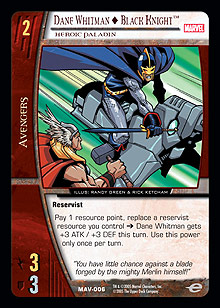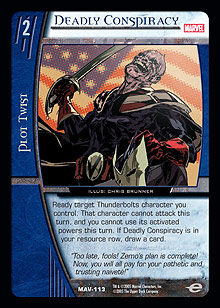
Many of the most popular decks in Vs. System, including this past year’s “decks to beat” (Avengers and Sentinels), are primarily on-curve strategies. This means that each turn, the ideal play for these decks is to recruit a single character that makes use of all of your resource points. There are numerous benefits to playing a curve-based archetype. For one thing, less of the cards that you draw need to be recruited. By only recruiting one character per turn, you leave yourself with more cards in hand and consequently with more options. This directly translates into being able to have fewer characters in your deck. On the other hand, curve decks do suffer from some fundamental problems. One of those problems is consistency. For today’s article, I would like to examine the latest build of Golden Age’s most popular curve archetype, Avengers. This version made Top 8 at last weekend’s $10K Bremen.
Avengers, Marcel Praet
 Characters
Characters
4 Black Panther
4 Rick Jones
4 Natasha Romanoff ◊ Black Widow, Super Spy
4 Quicksilver, Mutant Avenger
3 Beast, Furry Blue Scientist
4 Dane Whitman ◊ Black Knight
2 Hercules
4 Wonder Man
4 Carol Danvers ◊ Warbird
4 Hawkeye, Clinton Barton
4 She-Hulk, Gamma Bombshell
Plot Twists
3 Flying Kick
3 Savage Beatdown
2 System Failure
3 Heroes in Reserve
3 Mega-Blast
3 Call Down the Lightning
Locations
3 Avengers Mansion
Naturally, if this deck hits each of its drops, it’s a force to be reckoned with. A common refrain heard from players in both Constructed and Sealed Pack play goes something along the lines of, “He hit all of his drops. There was nothing I could do.” I couldn’t help but wonder just how often this happens. This build of Avengers doesn’t have any character search. It doesn’t have any way to get extra cards or improve the quality of its draws (with the exception of Call Down the Lightning, of course, but we’ll ignore that for now). This makes it relatively easy to calculate the chance that you will hit a given drop while playing this deck. I haven’t seen these kinds of figures elsewhere, so I will post a table here.
|
Turn X |
Chance of Playing X-Drop |
|
|
|
|
1 |
54.14% |
|
2 |
70.59% |
|
3 |
79.02% |
|
4 |
85.25% |
|
5 |
66.54% |
|
6 |
72.16% |
|
7 |
51.36% |
As you can see, you have a reasonable chance of missing each and every one of your drops. The most reliable drop in this deck, the 4-drop, will still be missed in roughly one game out of every six. Of course, these numbers are derived from this particular decklist, and they take into account neither intelligent mulligans nor Call Down the Lightning. The actual percentages should be slightly higher at each drop, but the point is still there. Before I continue with my discussion, here’s one more table detailing the chances of hitting every drop in this deck up to a certain point.
|
Turn X |
Chance of Playing First X Drops |
|
|
|
|
1 |
54.14% |
|
2 |
35.77% |
|
3 |
25.75% |
|
4 |
19.87% |
|
5 |
11.04% |
|
6 |
6.65% |
|
7 |
2.65% |
I find this set of numbers to be very, very interesting. Only one time in thirty-seven will this deck hit its entire curve. The vast majority of the time, it can expect to start missing drops as early as turn 2. The bottom line is that although this is a curve deck, it will be forced to play like an off-curve deck (or miss drops entirely) for a great number of turns in any given tournament. For a different deck, the numbers will change, but the general principle is the same. Missing drops in a curve deck is just part of the game. This raises the question: What cards can you include in your deck to mitigate the effect of these less-than-ideal turns?
Character Search
This is certainly the most popular choice, assuming it’s available to you. Adding four copies of your team’s generic search card to your deck has an effect approximately equal to that of adding an additional four copies of each character that the search card can fetch. For example, four copies of Signal Flare in a Common Enemy deck have approximately the same effect on consistency as adding twenty more characters to your deck. That’s an incredible amount of power for one card and the primary reason why search cards are a staple of any archetype in which they can fit.
Boost-Like Effects
 This Avengers deck doesn’t have character search, but it certainly has the potential to under-drop effectively. Cards like Dane Whitman ◊ Black Knight and Black Panther can effectively fill spots other than their own in the curve. In classic Curve Sentinels, Sentinel Mark V—and not any other character—is the card that makes the deck possible. Playing seven cards that function equally well as a 4- or 5-drop goes a long way toward ensuring that you hit the important parts of your curve.
This Avengers deck doesn’t have character search, but it certainly has the potential to under-drop effectively. Cards like Dane Whitman ◊ Black Knight and Black Panther can effectively fill spots other than their own in the curve. In classic Curve Sentinels, Sentinel Mark V—and not any other character—is the card that makes the deck possible. Playing seven cards that function equally well as a 4- or 5-drop goes a long way toward ensuring that you hit the important parts of your curve.
Grossly Overpowered Characters
This is another part of the path that Curve Sentinels takes. Bastion is an excellent 7-drop, and Nimrod is a fine 6-drop. Playing either one of these cards a turn late isn’t a big deal, because chances are that they’re more powerful than whatever your opponent is playing anyway. Melissa Gold ◊ Songbird, Sonic Carapace is another example of a card you don’t mind playing a turn late. If your team has a number of characters that seem to have misprinted recruit costs, that’s a good sign that your deck will be more resilient when it misses its curve.
Card-Drawing Effects
Though not as common as the other three card types in Tier 1 curve decks, card-drawing effects are certainly another way to help you hit your curve. Call Down the Lightning, for example, grants you a beneficial effect and also lets you see an additional card in your deck. Every easy-to-use card-drawing effect you play effectively shrinks the number of cards in your deck by one, making it more likely that you will draw the characters you need each turn.
These four items, I think, are what bridge the gap between a playable and an unplayable curve deck. Take a look at that list again and then shuffle through your curve deck of choice. If you don’t have at least a few of the four items I listed above, chances are that your deck isn’t up to snuff.
The thing that got me thinking about curve decks and consistency in the first place was Arkham Inmates. This team has fairly good plot twists, a good amount of synergy, and fine drops at every point of the curve. Surely, I thought, with the latest additions from the Justice League set, Arkham would rise to the level of tournament viability. Alas, it was not to be. When the Arkham deck hits its curve, it’s pretty impressive. When it doesn’t . . . well, it’s not so hot. Take a look back up to those tables. Even the most character-packed curve deck will be forced to under-drop an enormous amount of the time. If your deck only functions at an acceptable level when it hits all of its drops, and it has no way to dig for those drops, it might be time to start looking for another deck.
Agree? Disagree? Find some fault in my conditional probability calculations? I would like to hear from you. As always, you can find me at any domestic event or contact me via email at anand@metagame.com.
Mailbag
I got quite a few emails about my last article, and most of them were along these lines:
 Hi there. I enjoyed your article on the Thunderbolts. However, I still have trouble grasping the mechanic of playing something like Deadly Conspiracy (or Cosmic Radiation) along with Team Tactics. Both cards I have mentioned that re-ready the character specifically say that the character cannot attack. So, how do you justify playing Team Tactics on them and then attacking? In my mind, that is cheating. I realize that it is not because it’s been an acceptable strategy since MOR, but still I’m confused about it. I love the idea of getting a 4-drop to 60 ATK!
Hi there. I enjoyed your article on the Thunderbolts. However, I still have trouble grasping the mechanic of playing something like Deadly Conspiracy (or Cosmic Radiation) along with Team Tactics. Both cards I have mentioned that re-ready the character specifically say that the character cannot attack. So, how do you justify playing Team Tactics on them and then attacking? In my mind, that is cheating. I realize that it is not because it’s been an acceptable strategy since MOR, but still I’m confused about it. I love the idea of getting a 4-drop to 60 ATK!
I can understand how this combo is a little confusing. The trick of it—and no, it’s not cheating—is that both Deadly Conspiracy and Cosmic Radiation stop the affected character from attacking. However, they don’t say anything about characters that are already engaged in an attack. In other words, when a card says, “that character can’t attack,” all it means is that the character can’t be declared as an attacker. It becomes a little clearer that this is how it works if you look at cards like Crime and Punishment, Go in Swinging, and Mist Form. These are all effects that are clearly meant to give a bonus to an attacker. A better way to think of these cards is that they don’t let you declare any more attacks; any characters already attacking are free to go about their business. I hope this clears everything up.